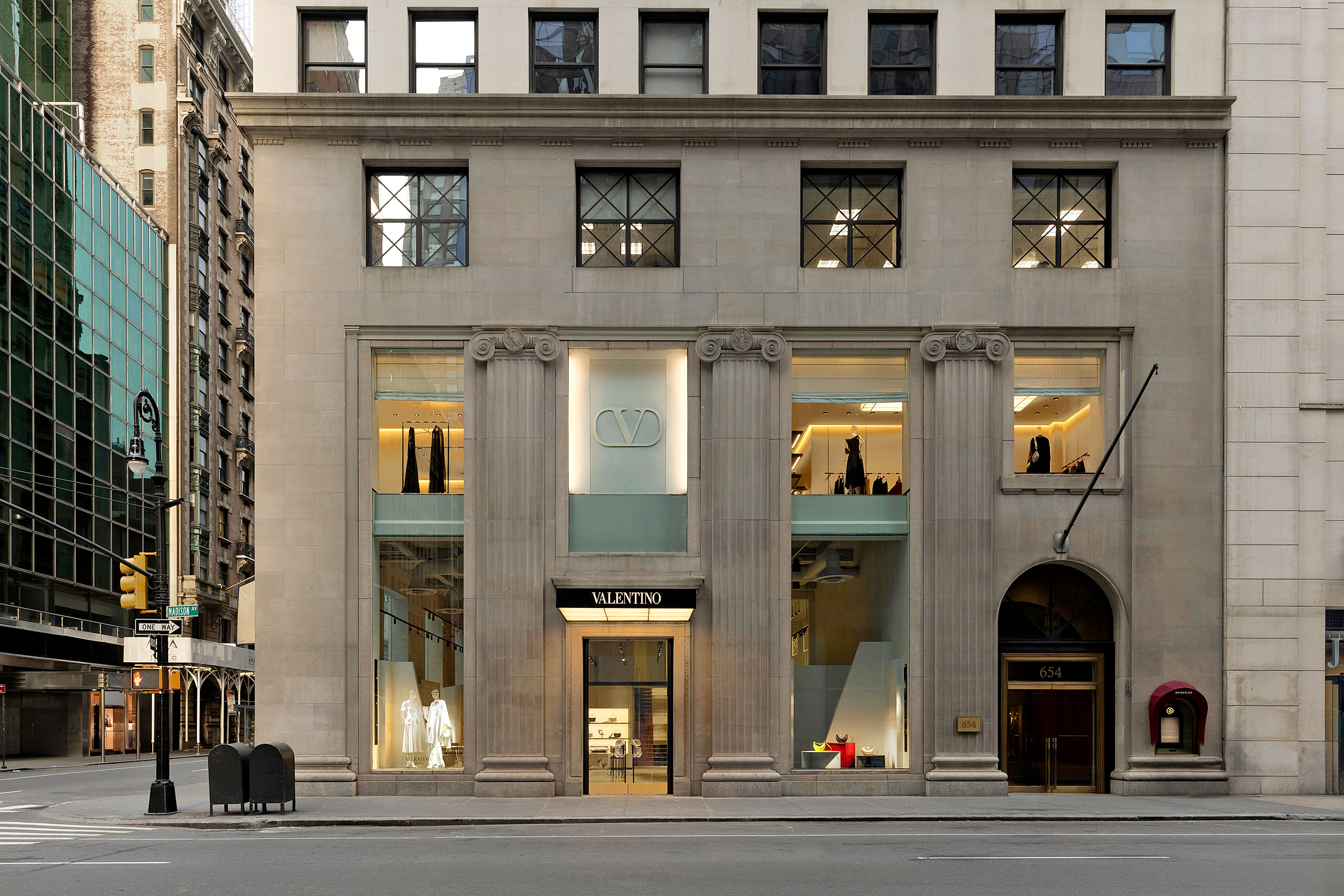
To celebrate the launch of its Madison Avenue flagship, its largest in the world, Valentino is exhibiting the work of renowned Italian painter Mario Schifano in the hyper-modern, concrete-clad mezzanine that presides over the new space.
The gleaming showcase is part of a collaboration with Magazzino Italian Art, a unique nonprofit museum and research center located upstate in the Hudson Valley—Cold Spring, to be exact—dedicated to Italian art, particularly Arte Povera. The only American museum specializing in Italian art, Magazzino was the natural choice as Valentino’s art partner in the Empire State.
Installation view of the Mario Schifano exhibition at Valentino’s new Madison Avenue flagship. Courtesy of Magazzino.
“The ethos of this collaboration is education,” said Magazzino’s executive director Vittorio Calabrese on a preview tour before the store’s November 10 launch. We’re “inviting a new community into the vibrant world of Italian art while supporting our programs.”
“Recognizing Valentino’s embodiment of quintessential Italian and Roman heritage,” he added, “we saw the maison as the ideal partner to explore a collaboration in support of our exhibition. Their creative team embraced the idea, and together with our conservators, exhibition designers, curators and art preparers, we crafted this project to introduce Mario Schifano [and] Rome during the decades of the ’60s and ’70s to a broader audience.”
Interior view of Valentino’s new Madison Avenue flagship. Courtesy of Magazzino.
Schifano, who died in 1998 at the age of 63, is one of the most significant artists of Italian postmodernism, known for his vibrant paintings that combine elements of Pop Art, Arte Povera, and Surrealism, and explored themes of consumerism and mass media. While few in number, his five paintings at the Valentino store bridge the worlds of art and fashion, Magazzino and Valentino, New York and Rome—and not just because the central work is rendered in the house’s signature shade of pink.
The collaboration comes with a major expansion of Magazzino, too, which was founded in 2017 by the collecting couple of Nancy Olnick and Giorgio Spanu. In September, the institution opened its Robert Olnick Pavilion (named after Nancy’s father) to further its curatorial and scholarly pursuits and increase its indoor space by two-thirds. The new building—designed by Alberto Campo Baeza and Miguel Quismondo—brings new auditorium capabilities, a store, and a cafe serving Italian cuisine by chef Luca Galli, straight from Livigno in the north of Italy.
Valentino creative director Pierpaolo Piccioli and Florence Pugh attend the 2023 Met Gala. (Photo by Sean Zanni/Patrick McMullan via Getty Images)
Valentino is well-versed in high-level art patronage. In 2022, the brand sponsored the Italian Pavilion at the 59th Biennale di Venezia. Pierpaolo Piccioli—the brand’s celebrated creative director since 2016—worked closely with the pavilion’s curator, Eugenio Viola, to develop a compelling narrative for the pavilion. The resulting exhibition, “History of Night and Fate of Comets,” featured the work of multidisciplinary artist Gian Maria Tosatti, whose immersive, evocative installations explored themes of time, memory, and the human condition.
Valentino has conversed with the art world in other ways, too. Over the years, its On Canvas initiative has shed light on contemporary and emerging painters and sculptors. For example, in Shanghai in 2020 and Beijing in 2021, the brand staged physical experiences in which its codes were interpreted by contemporary local artists, offering fresh perspective on the house’s history and DNA.
Installation view of the Mario Schifano exhibition at Valentino’s new Madison Avenue flagship. Courtesy of Magazzino.
In addition, Valentino participated in Frieze in Singapore and Seoul, again asking artists to reinterpret its iconic codes through their own prisms, producing novel works. Meanwhile, Valentino and Triennale Milano have partnered to present the exhibition “Pittura Italiana Oggi” (Italian Painting Today) that is currently on view (through February 11, 2024). The exhibition, curated by Damiano Gullì, features works by 120 Italian artists from the 1960s to the 2000s.
Further, convinced that painting is to contemporary art what couture is to fashion, Pierpaolo Piccioli recently brought a group of painters of all ages and backgrounds into the atelier to help design the Fall/Winter 2021-22 couture collection. The experimental process saw grandiose ball gowns and enormous hats loaded with vibrant colors and sinuous draping, trademarks of Valentino. As Calabrese said, “Valentino, like Magazzino, consistently champions new contemporary expressions while staying rooted in Italian heritage, captivating a global audience.”
Installation view of the Mario Schifano exhibition at Valentino’s new Madison Avenue flagship. Courtesy of Magazzino.
Valentino Garavani himself, the brand’s namesake (though no longer part of the company), is well-known in collecting circles. According to the Artnet Price Database, his colossal 1983 canvas by Jean-Michel Basquiat brought over $67 million at Christie’s in May. The painting, El Gran Espectaculo (The Nile), depicts floating skulls and figures set against scrawled phrases alluding to pharaohs and ancient Egyptian sites. It lived in Garavani’s personal collection for 18 years, and appeared in a 2010 issue of Vanity Fair, in which Garavani also spoke of owning works by Roy Lichtenstein, Andy Warhol, Willem de Kooning, Fernand Léger, and Richard Prince.
Following Schifano in its new Madison Avenue space, Valentino plans to host a series of exhibitions with Magazzino in the coming months, highlighting a range of Italian artists. Though he can’t say who exactly, Vittorio Calabrese did say that “Rome and New York will still be at the center of this dialogue. The collaboration serves as an avenue to delve deeper into Italy’s contemporary art landscape, amplifying its relevance on the global scene—the best of Italian culture.”